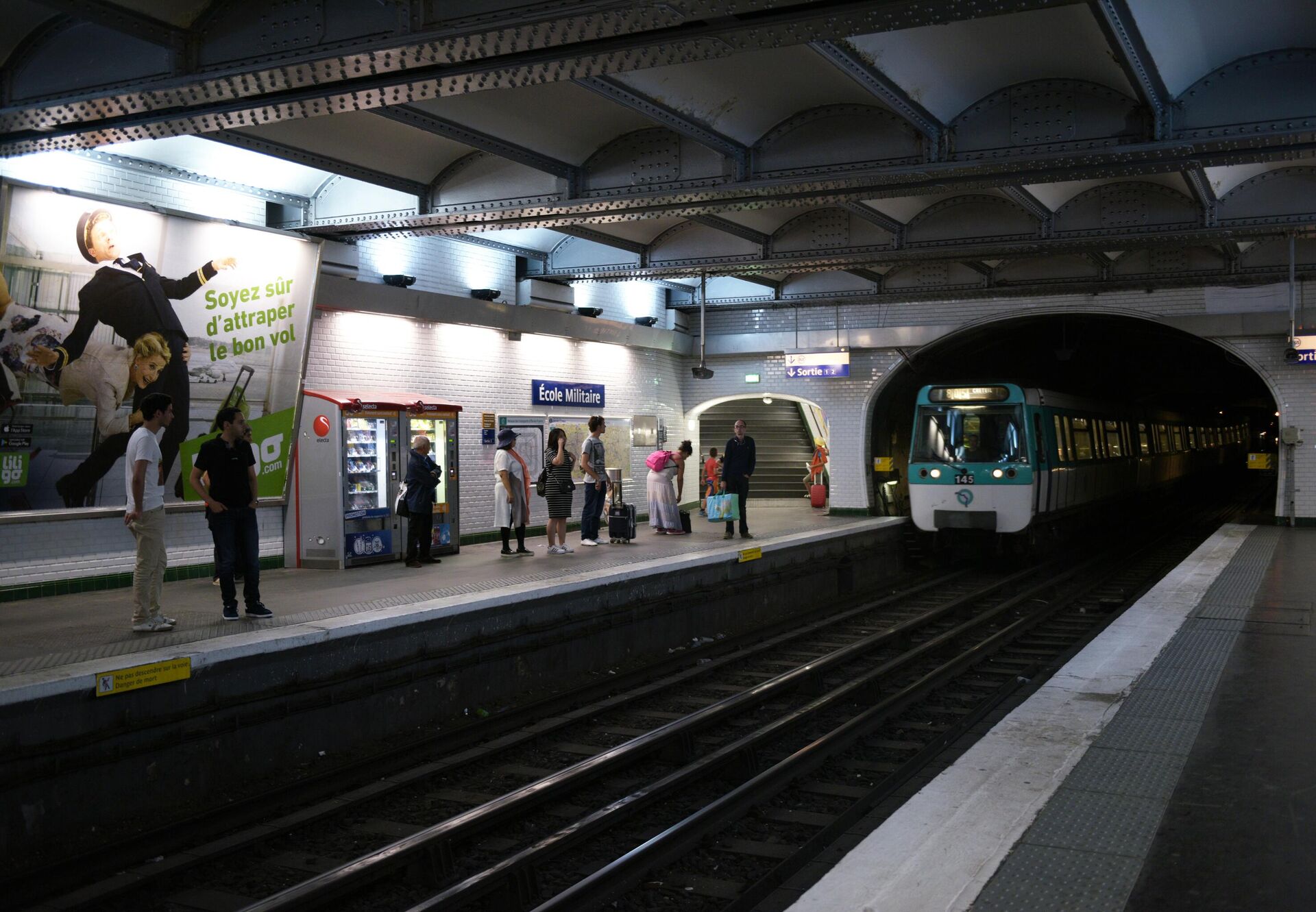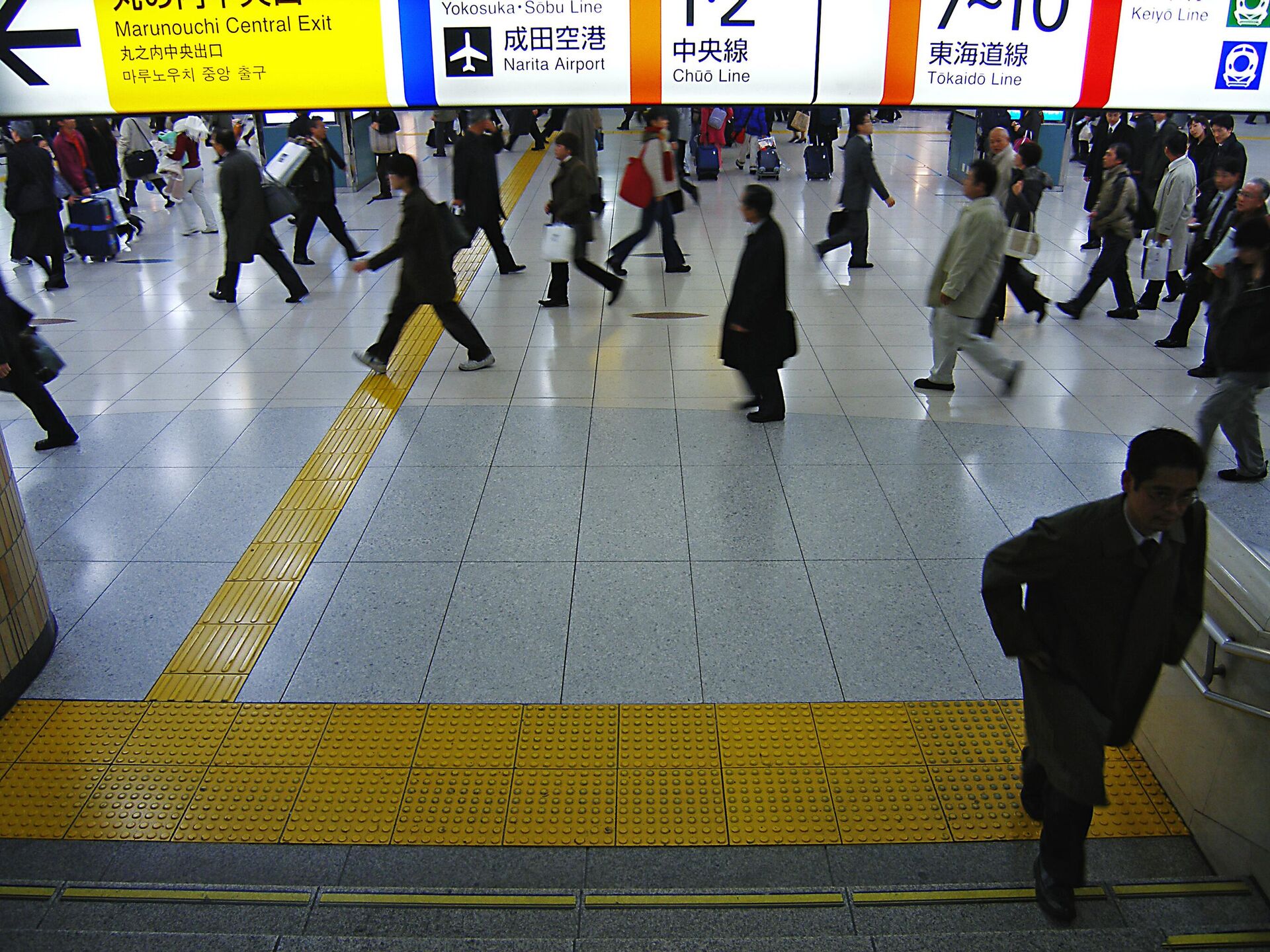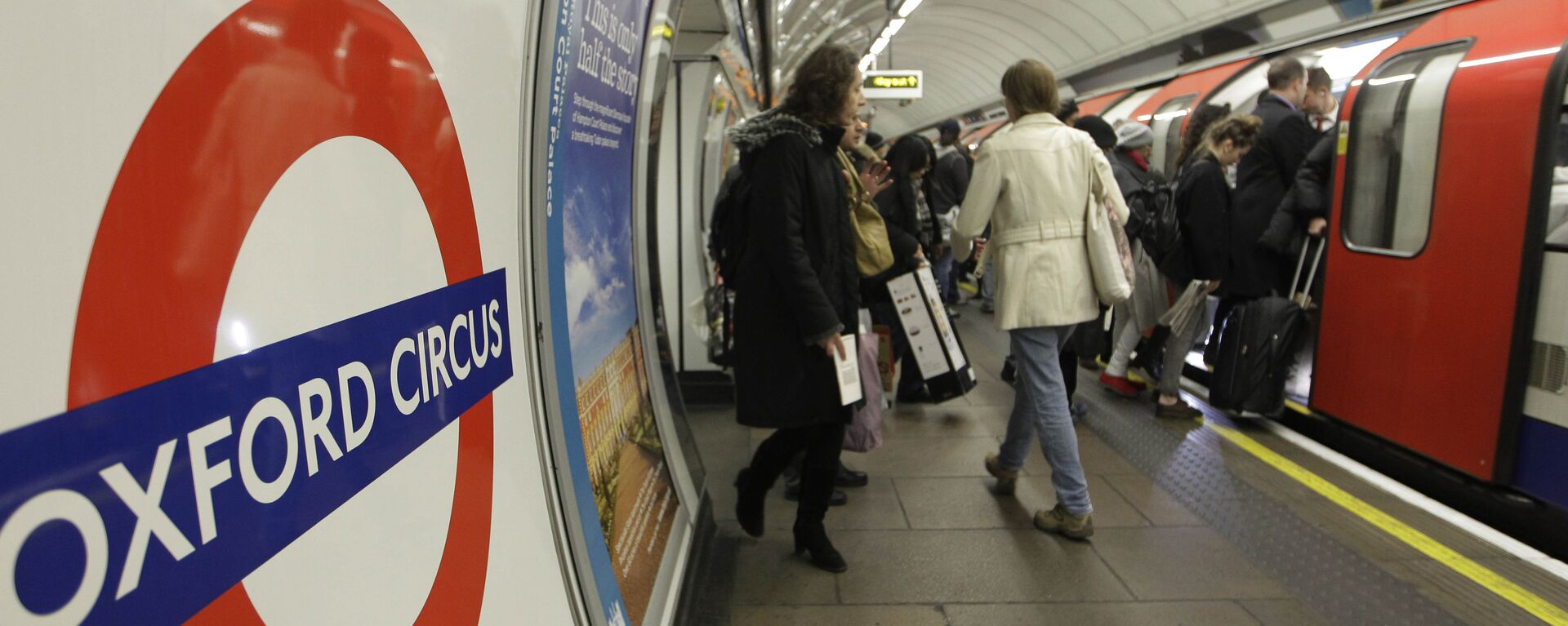https://sputnikglobe.com/20230109/as-the-london-underground-turns-160-what-are-the-worlds-most-famous-metros-1106163997.html
As the London Underground Turns 160, What Are the World’s Most Famous Metros?
As the London Underground Turns 160, What Are the World’s Most Famous Metros?
Sputnik International
The London Underground railway marks the 160th anniversary of the launch of its first line today. ‘The Tube’ has since become a pop-cultural icon of the... 09.01.2023, Sputnik International
2023-01-09T15:25+0000
2023-01-09T15:25+0000
2023-05-28T15:25+0000
world
london
metro
subway
united kingdom (uk)
https://cdn1.img.sputnikglobe.com/img/07e7/01/09/1106163848_0:123:3203:1925_1920x0_80_0_0_2c7698edccffa0fbcc856da8bb89a923.jpg
The revolutionary Metropolitan Railway — now the Metropolitan Line — opened on January 9 1863, running underground or through deep cuttings from Paddington to Farringdon Street through the heart of London.The trains were originally drawn by steam locomotives, necessitating large ventilation shafts at the stations and in the shallow ‘cut-and-cover’ tunnels. The small wooden carriages were divided into first- and second-class like long-distance trains, and were lit inside with gas-burning lamps.The service was immediately popular with Victorian, despite the noise and smoke from the engines. But the primitive and abrupt braking of the trains often caused injuries, and an official report in 1897 included the detail that a pharmacist was treating those suffering from the distress of their journeys with his special ‘Metropolitan Mixture’. The line and its rivals, such as the District Railway, were electrified by 1905.The Metropolitan line was extended above ground in stages until it ran north-west out of London to Uxbridge, Watford and Amersham. The new suburbs that sprang up along the line between the two world wars were nicknamed ‘Metro-Land’.The first deep line, tunneled through the London clay, was the City and South London Railway, now the Bank and Morden branches of the Northern Line, opened in 1890 with all-electrified trains. That was soon followed by the Waterloo and City line and the Central London Railway from Shepherd’s Bush in the west to the Bank of England in the east. The Central line was dubbed the ‘Twopenny Tube’ for its fare and circular tunnels, with the whole network eventually becoming known as ‘The Tube’.Underground stations were used as makeshift bomb shelters during the Nazi ‘Blitz’ bombing campaign on London in 1940 and 1941. Expansion continued after the war, with the Jubilee Line named in honor of Queen Elizabeth II’s silver jubilee in 1977 finally opened in 1979. The Queen also lent her name to the newest addition to the network: the Elizabeth Line, formerly known as Crossrail, runs from Reading and Heathrow airport to the west of London to Abbey Wood in Kent and Shenfield in Essex.Smoking on trains was banned in the 1970s, and in stations after the 1987 King’s Cross escalator fire disaster. The Tube is still known for overcrowded trains — so sweltering in summer that passengers sometimes faint — and frequent service delays and breakdowns. But it also its a place in British popular culture.The London Underground symbol of red circle transfixed by a blue bar is recognized around the world, along with its signature Johnston Sans typeface.ParisOpened in July 1900, the Paris Metro is the second-busiest urban railway system in the world — after Moscow — and carries more than 4 million passengers a day.Unlike the London Underground, built piecemeal by competing companies, the Paris metro was planned as an integrated network of lines from the start by the city authorities, which built the tunnels and tracks.The “Metropolitain” is known for its art-deco entrance arches and some colorful station names — comtrast Stalingrad and Pont de l'Alma, both named after famous battles fought in Russia, with London’s Waterloo — but also for the ‘unique’ aroma of the stations and tunnels, where Parisian men relieve themselves against the walls.New YorkThe New York Subway first opened in 1904, just a few years after the Paris Metro. Forward-thinking planners designed the system with dual tracks in some sections, allowing the running of express services alongside trains that serve every station, and for 24-hour operation without having to shut down whole routes for nightly maintenance.The subway has a reputation for filth, graffiti and violent crime, which reached their nadir in the 70s and 80s. Since then the Metropolitan Transportation Authority has cleaned up the trains and made efforts to tackle criminality. However, the January 2022 murder of Michelle Go, who was pushed onto the track by a mentally ill man, highlighted the fact that 47 people had been killed on the network in the previous eight months — some in gruesome suicides by throwing themselves in front of trains or onto the high-voltage third rail.MoscowPlanning for Moscow’s underground rail network began in the Tsarist era, but work did not begin until after the revolution and ensuing civil war.Plans for the 10-line network were finalized in 1933, and the first line opened two years later, using German-made electric trains. 285,000 people rode the metro on its first day.The Moscow Metro is renowned as the most beautiful of all urban rapid transit systems, with its gleaming vaulted corridors decorated with statues and marble floors and lit by chandeliers. A song was composed in its honor on its opening, and the Bolshoi Theatre held a concert with a choir of over 2,000 metro workers.British Architect Charles Holden was hired, along with London Underground general manager Frank Pick, to design many of the stations after Soviet planners were impressed by his work on the new Piccadilly Line. Holden’s post-WWII design for Gant’s Hill station on the Central Line in North-East London in turn echoes the style of the Moscow Metro stations.The Moscow Metro now serves some 2.5 billion passenger journeys every year, making it the busiest such network in the world.TokyoServing the world’s most populous urban area, the Tokyo Metro is renowned for its typical Japanese orderliness and painstaking punctuality to margins of less than a minute.But with nearly seven million journeys made per day, it is overcrowded to the point that station staff — wearing immaculate white gloves — are employed to shove passengers into the packed carriages, sometimes with brooms.The metro also has a seedier side. Female-only carriages were introduced, starting in the 2000s, after complaints of men groping women and snapping up-skirt photos reached record highs.PyongyangAlmost as grand as the Moscow Metro is that of North Korea’s capital Pyongyang. Carved stone columns and elaborate lighting is complemented by imposing murals of the DPRK’s founder Kim Il Sung, who ordered its construction in the late 60s and early 70s.The network reportedly uses trains from the Berlin U-Bahn — which also boasts some of the prettiest subterranean stations — bought in the 1990s after East Germany’s annexation by the West.The Pyongyang metro is unusual for having now overground stretches in suburban districts, and for being one of the deepest railways at 110 meters, where the temperature is a steady 18 degrees Celsius all year round. The stations are specifically designed to serve as bomb shelters in case of nuclear war, with blast doors built into the corridors.
https://sputnikglobe.com/20180313/london-bans-brexit-advert-1062482183.html
https://sputnikglobe.com/20200515/85th-anniversary-of-moscow-metro-top-8-most-interesting-facts-about-underground-kingdom-1079318594.html
london
united kingdom (uk)
Sputnik International
feedback@sputniknews.com
+74956456601
MIA „Rossiya Segodnya“
2023
James Tweedie
https://cdn1.img.sputnikglobe.com/img/07e4/08/1c/1080307270_0:3:397:400_100x100_80_0_0_7777393b9b18802f2e3c5eaa9cbcc612.png
James Tweedie
https://cdn1.img.sputnikglobe.com/img/07e4/08/1c/1080307270_0:3:397:400_100x100_80_0_0_7777393b9b18802f2e3c5eaa9cbcc612.png
News
en_EN
Sputnik International
feedback@sputniknews.com
+74956456601
MIA „Rossiya Segodnya“
Sputnik International
feedback@sputniknews.com
+74956456601
MIA „Rossiya Segodnya“
James Tweedie
https://cdn1.img.sputnikglobe.com/img/07e4/08/1c/1080307270_0:3:397:400_100x100_80_0_0_7777393b9b18802f2e3c5eaa9cbcc612.png
london metro, london metro anniversary, subway, underground public transport, metro around the world, metro across the globe
london metro, london metro anniversary, subway, underground public transport, metro around the world, metro across the globe
As the London Underground Turns 160, What Are the World’s Most Famous Metros?
15:25 GMT 09.01.2023 (Updated: 15:25 GMT 28.05.2023) The London Underground railway marks the 160th anniversary of the launch of its first line today. ‘The Tube’ has since become a pop-cultural icon of the British capital.
The revolutionary Metropolitan Railway — now the Metropolitan Line — opened on January 9 1863, running underground or through deep cuttings from Paddington to Farringdon Street through the heart of London.
The trains were originally drawn by steam locomotives, necessitating large ventilation shafts at the stations and in the shallow ‘cut-and-cover’ tunnels. The small wooden carriages were divided into first- and second-class like long-distance trains, and were lit inside with gas-burning lamps.
The service was immediately popular with Victorian, despite the noise and smoke from the engines. But the primitive and abrupt braking of the trains often caused injuries, and an official report in 1897 included the detail that a pharmacist was treating those suffering from the distress of their journeys with his special ‘Metropolitan Mixture’. The line and its rivals, such as the District Railway, were electrified by 1905.
The Metropolitan line was extended above ground in stages until it ran north-west out of London to Uxbridge, Watford and Amersham. The new suburbs that sprang up along the line between the two world wars were nicknamed ‘Metro-Land’.
The first deep line, tunneled through the London clay, was the City and South London Railway, now the Bank and Morden branches of the Northern Line, opened in 1890 with all-electrified trains. That was soon followed by the Waterloo and City line and the Central London Railway from Shepherd’s Bush in the west to the Bank of England in the east. The Central line was dubbed the ‘Twopenny Tube’ for its fare and circular tunnels, with the whole network eventually becoming known as ‘The Tube’.
Underground stations were used as makeshift bomb shelters during the Nazi ‘Blitz’ bombing campaign on London in 1940 and 1941. Expansion continued after the war, with the Jubilee Line named in honor of Queen Elizabeth II’s silver jubilee in 1977 finally opened in 1979. The Queen also lent her name to the newest addition to the network: the Elizabeth Line, formerly known as Crossrail, runs from Reading and Heathrow airport to the west of London to Abbey Wood in Kent and Shenfield in Essex.
Smoking on trains was banned in the 1970s, and in stations after the 1987 King’s Cross escalator fire disaster. The Tube is still known for overcrowded trains — so sweltering in summer that passengers sometimes faint — and frequent service delays and breakdowns. But it also its a place in British popular culture.
The London Underground symbol of red circle transfixed by a blue bar is recognized around the world, along with its signature Johnston Sans typeface.
Opened in July 1900, the Paris Metro is the second-busiest urban railway system in the world — after Moscow — and carries more than 4 million passengers a day.
Unlike the London Underground, built piecemeal by competing companies, the Paris metro was planned as an integrated network of lines from the start by the city authorities, which built the tunnels and tracks.
The “Metropolitain” is known for its art-deco entrance arches and some colorful station names — comtrast Stalingrad and Pont de l'Alma, both named after famous battles fought in Russia, with London’s Waterloo — but also for the ‘unique’ aroma of the stations and tunnels, where Parisian men relieve themselves against the walls.
The New York Subway first opened in 1904, just a few years after the Paris Metro. Forward-thinking planners designed the system with dual tracks in some sections, allowing the running of express services alongside trains that serve every station, and for 24-hour operation without having to shut down whole routes for nightly maintenance.
The subway has a reputation for filth, graffiti and violent crime, which reached their nadir in the 70s and 80s. Since then the Metropolitan Transportation Authority has cleaned up the trains and made efforts to tackle criminality. However, the January 2022 murder of Michelle Go, who was pushed onto the track by a mentally ill man, highlighted the fact that 47 people had been killed on the network in the previous eight months — some in gruesome suicides by throwing themselves in front of trains or onto the high-voltage third rail.
Planning for Moscow’s underground rail network began in the Tsarist era, but work did not begin until after the revolution and ensuing civil war.
Plans for the 10-line network were finalized in 1933, and the first line opened two years later, using German-made electric trains. 285,000 people rode the metro on its first day.
The Moscow Metro is renowned
as the most beautiful of all urban rapid transit systems, with its gleaming vaulted corridors decorated with statues and marble floors and lit by chandeliers. A song was composed in its honor on its opening, and the Bolshoi Theatre held a concert with a choir of over 2,000 metro workers.
British Architect Charles Holden was hired, along with London Underground general manager Frank Pick, to design many of the stations after Soviet planners were impressed by his work on the new Piccadilly Line. Holden’s post-WWII design for Gant’s Hill station on the Central Line in North-East London in turn echoes the style of the Moscow Metro stations.
The Moscow Metro now serves some 2.5 billion passenger journeys every year, making it the busiest such network in the world.
Serving the world’s most populous urban area, the Tokyo Metro is renowned for its typical Japanese orderliness and painstaking punctuality to margins of less than a minute.
But with nearly seven million journeys made per day, it is overcrowded to the point that station staff — wearing immaculate white gloves — are employed to shove passengers into the packed carriages, sometimes with brooms.
The metro also has a seedier side. Female-only carriages were introduced, starting in the 2000s, after complaints of men groping women and snapping up-skirt photos reached record highs.
Almost as grand as the Moscow Metro is that of North Korea’s capital Pyongyang. Carved stone columns and elaborate lighting is complemented by imposing murals of the DPRK’s founder Kim Il Sung, who ordered its construction in the late 60s and early 70s.
The network reportedly uses trains from the Berlin U-Bahn — which also boasts some of the prettiest subterranean stations — bought in the 1990s after East Germany’s annexation by the West.
The Pyongyang metro is unusual for having now overground stretches in suburban districts, and for being one of the deepest railways at 110 meters, where the temperature is a steady 18 degrees Celsius all year round. The stations are specifically designed to serve as bomb shelters in case of nuclear war, with blast doors built into the corridors.












